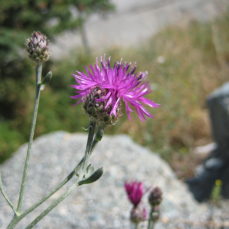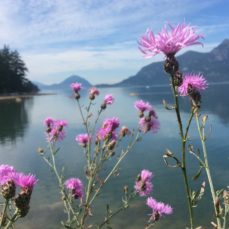Spotted Knapweed (Centaurea stoebe)

Management Strategy
Squamish
Whistler
Pemberton
Vectors of Spread
Synonyms
Centaurea maculosa
Centaurea biebersteinii
ID Characteristics
General: Spotted knapweed is a biennial or short-lived perennial. It starts out as a rosette and can remain that way for several years before bolting and dying in a subsequent season.
Flowers: Light purple and aromatic, growing individually at the end of upright stems. The flower bracts (lower flower head fringe) have black tips, giving the plant a spotted appearance, hence its name. Closed flowerheads are egg-shaped.
Stems: Upright and 1 – 1.5 m tall.
Leaves: Deeply lobed, hairy, alternate and covered with translucent dots. Leaves grow up to 15cm long.
Seeds: Bristled seeds.
Roots: Stout taproot.
Similar Species
Invasive
Diffuse knapweed (Centaurea diffusa) has white flowers.

Diffuse Knapweed (Bryan Kelly-McArthur)
Meadow knapweed (Centaurea debeauxii) has undivided leaves and larger flowerhead bracts with comb-like fringes at the tips.

Photo credit: John Cardina, The Ohio State University, Bugwood.org
Russian knapweed (Centaurea repens or Acroptilon repens) has smaller flowers and no black marks on the bracts.

Photo credit: BC Ministry of Forests
Black knapweed (Centaurea nigra) is shorter (about 10 – 80 cm tall) with pink to purple flowers.

Photo credit: Wikipedia
Brown knapweed (Centaurea jacea) has pink flowers and lace-shaped or elliptic leaves.

Photo credit: Wikipedia
Habitat and Origin
Spotted knapweed was introduced from Eurasia in the early 1900s, likely as a seed contaminant.
Spotted knapweed typically grows in low to mid-elevation open areas and well-drained soils, like grasslands, open forests and woodland clearings. It is tolerant of a wide range of soil moisture levels.
How it Spreads
Spotted knapweed reproduces mainly by seed. This species can produce up to 140,000 seeds per square meter (and up to 900 seeds per individual plant), and seeds remain viable in the soil for over 8 years. Seeds are self-fertile, but can also be cross-pollinated by insects.
Spotted knapweed is a biennial or short-lived perennial that begins its life as a rosette. This rosette stage can persist for several years before the plant bolts and completes its life cycle in the following season.
Most spotted knapweed seeds fall in the immediate area around the parent plant. For long-distance dispersal, seeds can spread by the wind and in contaminated hay, gravel or soil; seeds can also spread by clinging to animals and the undercarriages of vehicles.
Impacts
Ecological:
- Displaces native species, threatening biodiversity.
- Displays allelopathic properties: produces chemical compounds that prevent the growth of other species.
- Increases runoff and erosion, leading to sedimentation of watercourses.
- Creates a fire hazard due to natural oils in the plant.
Health:
- Causes skin irritation.
Stop the Spread
Spotted knapweed is abundant in certain portions of the Sea to Sky region, but has not yet infested all potential habitats. The goal is to contain the spread of spotted knapweed to Pemberton / ISMA 3.
Learn to identify spotted knapweed: use the images presented in this profile page to learn how to identify spotted knapweed.
What to do if you spot it: You can report any spotted knapweed sighting by visiting our reporting page.
DO:
- Regularly monitor properties for weed infestations.
- Ensure soil and gravel are uncontaminated before transport.
- Check wildflower mixes to ensure that they do not contain spotted knapweed.
- Minimize soil disturbances (e.g. use grazing plants that prevent soil exposure from overgrazing), and use seed misses with dense, early colonization (e.g. alfalfa or barely) to revegetate exposed soil and resist invasion.
- Ensure that plants are disposed of in a garbage bag if found in floral arrangements to prevent seeds from spreading.
- Maintain grasslands in a healthy, vigorous condition to ensure a productive, competitive plant community.
DO NOT:
- Unload, park or store equipment or vehicles in infested areas; remove plant material from any equipment, vehicles, or clothing used in such areas and wash equipment and vehicles at designated cleaning sites before leaving infested areas.
- Plant spotted knapweed in a garden, no matter how well-contained its enclosure may seem.
- Move soil that has been contaminated with spotted knapweed.
Control
Mechanical
Hand-pull small infestations before seed set; note that repeated hand-pulling is necessary during the season and must be maintained over several years, as seeds can remain dormant in the soil for long periods. Every effort should be made to remove the whole taproot with little soil disturbance. If this is not possible, cut the root 5 – 10 cm below the soil surface. Mowing is ineffective, as plants mowed in the rosette stage will quickly recover, and mowing too late (after seed set) will disperse seeds.
Chemical
Effective herbicides include dicamba, 2,4- D, clopyralid, aminopyralid and glyphosate. Picloram is also effective, however it is not suited for wet, coastal soils. Herbicides are generally most effective on spotted knapweed when applied to the rosette. Herbicide control must be completed for at least 2 years to be effective.
We recommend that any herbicide application is carried out by a person holding a valid BC Pesticide Applicator Certificate. Before selecting and applying herbicides, you must review and follow herbicide labels and application rates; municipal, regional, provincial and federal laws and regulations; species-specific treatment recommendations, and site-specific goals and objectives.
Biological
Twelve biocontrol agents have been released in BC for knapweeds. They are most effective when used in combination. Several agents show promise for a variety of habitats.
Cultural
Grazing is not an effective eradication method; however having cattle, sheep, and goats graze spotted knapweed in early spring may help suppress flower and seed production.
Sea to Sky Distribution
Spotted Knapweed Factsheet
Having trouble viewing the factsheet? Don’t worry, all the information is included on this page. You can also contact us with any questions.
Additional Resources
References
- Alberta Invasive Species Council, Knapweed, Spotted
- Capital Region Invasive Species Program, High Priority Species Invasive Species Alert Sheet
- Electronic Atlas of the Flora of British Columbia, Centaurea stoebe
- Government of British Columbia, “Spotted Knapweed” in A Guide to Weeds in British Columbia
- Invasive Species Council of BC, Spotted Knapweed
- Invasive Species Council of BC, Spotted Knapweed TIPS Factsheet
- Lillooet Regional Invasive Species Society, Spotted Knapweed (Centaurea stoebe)
- Okanagan Invasive Species Online (OISO), Spotted and Diffuse Knapweed
- Ontario Invasive Species Council, Best Management Practices in Ontario for Spotted Knapweed (Centaurea stoebe)
- University of California Weed Research & Information Centre, “Spotted knapweed” in Weed Control in Natural Areas in the Western United States














